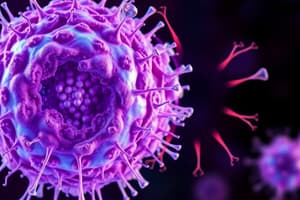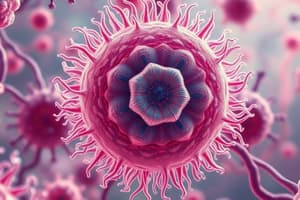Podcast
Questions and Answers
Explain how the surface-to-volume ratio affects a cell's ability to survive, and why this is important for cell size.
Explain how the surface-to-volume ratio affects a cell's ability to survive, and why this is important for cell size.
As a cell increases in size, its surface area increases more slowly than its volume. Nutrients enter and wastes leave at the surface, so a large cell has difficulty transporting enough nutrients and expelling wastes, leading to cell death. Thus, the surface-to-volume ratio limits cell size.
Contrast the functions of light microscopes and electron microscopes in cell biology.
Contrast the functions of light microscopes and electron microscopes in cell biology.
Light microscopes are inexpensive and simple to operate but have lower resolution. Electron microscopes are complex and expensive but provide much higher resolution, allowing for the visualization of finer cellular details.
How does the structure of a sperm cell reflect its function in reproduction?
How does the structure of a sperm cell reflect its function in reproduction?
A sperm cell is streamlined with a whiplike tail for swimming. It also contains an enzyme-containing sac in its head to digest a path through the egg for fertilization.
Why does a mature red blood cell lack a nucleus and most organelles? What advantage does this provide?
Why does a mature red blood cell lack a nucleus and most organelles? What advantage does this provide?
Summarize the functions of the plasma membrane in all cells.
Summarize the functions of the plasma membrane in all cells.
Describe the 'fluid mosaic model' of the plasma membrane.
Describe the 'fluid mosaic model' of the plasma membrane.
Explain why the selective permeability of the plasma membrane is crucial for cell survival.
Explain why the selective permeability of the plasma membrane is crucial for cell survival.
How do membrane glycoproteins contribute to cell-cell recognition?
How do membrane glycoproteins contribute to cell-cell recognition?
According to the cell theory, where do new cells come from?
According to the cell theory, where do new cells come from?
What are the two basic types of cells?
What are the two basic types of cells?
Name an example of a microscopic organism from the group called 'Archaea'.
Name an example of a microscopic organism from the group called 'Archaea'.
Which type of cells contains membrane bound orgenelles?
Which type of cells contains membrane bound orgenelles?
Name two non-membranous organelles found in both prokaryotic and eukaryotic cells.
Name two non-membranous organelles found in both prokaryotic and eukaryotic cells.
Which type of cell is generally simpler and smaller in structure, eukaryotic or prokaryotic?
Which type of cell is generally simpler and smaller in structure, eukaryotic or prokaryotic?
Give an example of an organelle in eukaryotic cells that has a membrane.
Give an example of an organelle in eukaryotic cells that has a membrane.
State the three components that make up the plasma membrane.
State the three components that make up the plasma membrane.
Describe the configuration of the phospholipid bilayer.
Describe the configuration of the phospholipid bilayer.
How does cholesterol contribute to the plasma membrane?
How does cholesterol contribute to the plasma membrane?
Explain the distinction between glycolipids and glycoproteins within the plasma membrane.
Explain the distinction between glycolipids and glycoproteins within the plasma membrane.
What is the advantage of using an electron microscope over a light microscope in biological studies?
What is the advantage of using an electron microscope over a light microscope in biological studies?
Flashcards
The Cell Theory
The Cell Theory
The fundamental organizing principle of biology; states that the cell is the smallest unit of life, cells make up all living things, and new cells arise from pre-existing cells.
Prokaryotic Cells
Prokaryotic Cells
Structurally simpler and typically smaller than eukaryotic cells, limited to bacteria and archaea.
Eukaryotic cells
Eukaryotic cells
Cells of plants, animals, and other organisms (except bacteria and archaea); contain membrane-bound organelles.
Organelle Definition
Organelle Definition
Signup and view all the flashcards
Surface-to-volume ratio
Surface-to-volume ratio
Signup and view all the flashcards
Light Microscopy
Light Microscopy
Signup and view all the flashcards
Plasma Membrane
Plasma Membrane
Signup and view all the flashcards
Phospholipid Bilayer
Phospholipid Bilayer
Signup and view all the flashcards
Membrane Proteins
Membrane Proteins
Signup and view all the flashcards
Glycoprotein
Glycoprotein
Signup and view all the flashcards
Fluid Mosaic Model
Fluid Mosaic Model
Signup and view all the flashcards
Selectively permeable
Selectively permeable
Signup and view all the flashcards
Cell-cell recognition
Cell-cell recognition
Signup and view all the flashcards
Study Notes
- The cell is studied
- Lesson outline includes:
- Eukaryotic vs prokaryotic cells
- Plasma membrane
- Cell size and microscopy
- Organelles and cytoskeleton
- Cell structure and function
- Cellular respiration and fermentation in ATP generation
Introduction
- The cell theory is a guiding principle in biology
- The cell theory states that:
- A cell is the smallest unit of life.
- Cells make up all living things, from unicellular to multicellular.
- New cells arise only from preexisting cells.
- Eukaryotic and prokaryotic cells are the two basic types of cells
Prokaryotic Cells
- Structurally simpler and typically smaller than eukaryotic cells
- Limited to bacteria and archaea
- Some bacteria inhabit the body harmlessly, though others can cause illness
- Archaea include species that inhabit extreme environments
Eukaryotic Cells
- The cells of plants, animals, and all other organisms except bacteria and archaea
- All the cells that make up your body
- The key difference with prokaryotic cells is the presence of membrane-bound organelles
- An organelle, or "little organ", is a component within a cell performing specific functions
- Some organelles have membranes, others do not
- Non-membranous organelles like ribosomes and cytoskeletal elements are in both prokaryotic and eukaryotic cells.
- Membrane-bound organelles like mitochondria and endoplasmic reticulum are unique to eukaryotic cells
Cell Size and Microscopy
- Most eukaryotic and prokaryotic cells are measured in micrometers (µm), or 1/1000 meters (m)
- Cell size is dictated by the surface-to-volume ratio, where surface area increases more slowly than volume as the cell grows
- Nutrients enter and wastes leave a cell at its surface
- A large cell would struggle to transport nutrients and waste across its surface area, and would die
- A small cell has sufficient surface area for uptake and removal of substances
- Most cells are small and require a microscope to see them
- Microscopic specimens are imaged using light or electron beams
- Light microscopes are inexpensive and simple to operate
- Electron microscopes are more complex and expensive, but can reveal finer details due to the shorter wavelength of electron beams
Cell Structure and Function
- A cell's structure reflects its functions
- Sperm cells are specialized for swimming and fertilizing eggs
- They are streamlined with a whiplike tail
- They have an enzyme-containing sac that digests a path to the egg
- Eggs are immobile, larger than typical cells, and packed with nutrients to initiate development
- Mature red blood cells extrude their nucleus and most organelles to make space for hemoglobin, the protein that transports oxygen
- Mature red blood cells are an exception to the rule of eukaryotic cells having a well-defined nucleus
Plasma Membrane
- The plasma membrane, or outer surface, controls the movement of substances in and out of the cell
- As a cell's interior must remain balanced, molecules and ions cannot move randomly in and out
- Both prokaryotic and eukaryotic cells have a plasma membrane
- Only eukaryotic cells also have internal membranes that divide the cell into compartments
- Each compartment is specialized for particular functions and contains its own assortment of enzymes
- The principles described for the plasma membrane also apply to the membranes inside the cell
Plasma Membrane Structure
- Made of lipids, proteins, and carbohydrates
- Molecules with hydrophilic (water-loving) heads and hydrophobic (water fearing) tails form a phospholipid bilayer
- Hydrophilic heads face both the extracellular fluid (interstitial fluid) outside the cell and the cytoplasm (jelly-like solution) inside the cell
- The cytoplasm includes contents between the plasma membrane and the nucleus
- Hydrophobic tails within the phospholipid bilayer point toward each other and hold the plasma membrane together
- Proteins interspersed in the phospholipid bilayer may be embedded in the membrane or span the bilayer completely
- Molecules of cholesterol are scattered throughout the bilayer
- Carbohydrates attach only to the outer surface of the plasma membrane
- Most carbohydrates are attached to proteins, forming glycoproteins, which function in cell recognition
- Other carbohydrates are attached to lipids, forming glycolipids
- The plasma membrane structure is described as a fluid mosaic
- Proteins interspersed among the lipid molecules like tiles of different colors within a mosaic
- Proteins can move sideways through the bilayer, giving the membrane a fluid quality
Plasma Membrane Functions
- Performa vital functions for the cell
- Maintains cells structural integrity by imposing a boundary between the internal and external environment, regulating the movement of substances into and out of the cell, permitting entry to some substances but excluding others
- Described as selectively permeable
- Functions in cell-cell recognition by recognizing molecules, often glycoproteins, on the cell surface
- Membrane glycoproteins differ between species and among individuals of the same species
Studying That Suits You
Use AI to generate personalized quizzes and flashcards to suit your learning preferences.




